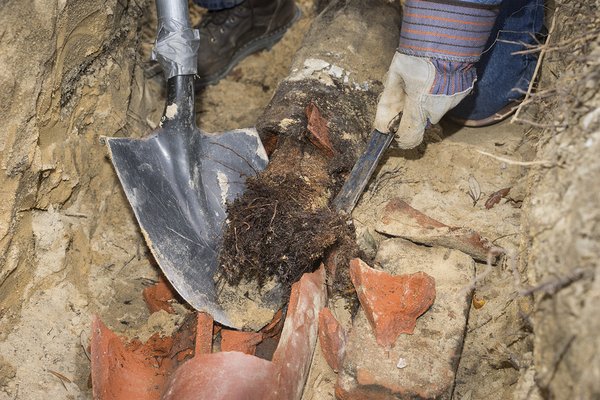Is there anything homier than the curb appeal of a house with mature trees all around? Trees clean toxins from the air, provide shade, block winds and give birds and squirrels a nice place to live. But they can also cause plumbing problems.
Every home is likely to have a drain line blockage at one time or another. But a tree root is no ordinary clog. When the roots infiltrate a sewer line, oftentimes the only sign is a progressively slower drain until eventually the pipe breaks. Here’s how it happens and how to spot the signs of a tree root gone awry.
Trees Seek out Sources of Water
It’s no accident when tree roots set up housekeeping inside a home’s main sewer line. In mature trees, roots can be enormous, long, tangled things that spread out far and wide. Root seek moisture, which is something in steady supply with a sewer line.
Roots don’t tend to break into sewer lines unless there’s already a leak or weak point. A small crack or weak fitting lets water seep into the soil, and that’s what attracts the roots in the first place. Some clay sewer lines continually let water seep out. As roots grow toward the moisture, they seek out the source, finding it inside the drain. Roots can grow for years before causing serious damage. Caught early, an auger might clear them out.
The Most Obvious Clue is Slow Drains Throughout the House
With an ordinary clog, some drains might still flow freely. Unless the material is lodged in the main sewer line, the drains closest to the street are more likely to flow like they should. If some of the toilets flush normally and a few drains seem unaffected, chances are it’s a typical clog that just needs an auger or a bottle of liquid drain opener.
If tree roots have blocked the line, Popular Mechanics says everything from one end of the house to the other will run slowly or not at all. Toilets will back up, sinks will fill without a stopper in place and no amount of plunging or drain opener will help.

If the affected pipe is easy to access, the work might be completed in a day.
Repair is Sometimes Costly and Involved
In minor cases, a plumber can run an auger through the sewer line and clear away small, thin, web-like roots that have settled in. But if the condition has progressed, a more powerful tool with a blade might be necessary. In a worst-case scenario, there may be no repair besides cutting out the damage and replacing the pipe.
Eco Plumber says repair or replacement of the damaged section is arguably the best way for a homeowner to handle roots in the sewer line. As long as water continues to leak out, tree roots will grow toward the source. Depending on the depth of the line, ease of access and how much pipe is affected, the work might be simple or quite expensive and labor-intensive.
For such beautiful things, trees can also wreak havoc for homeowners, especially once a late-species tree is mature. Because roots grow beneath the soil, there’s no real way to know if they’re threatening the sewer line or if they’ve already moved in. But if all of the drains run slow, it’s a safe bet that the situation won’t improve without professional intervention.
As a certified home inspector, you’ll eventually find defects in every imaginable home system. Thankfully, your training prepares you to handle what the job throws at you. If your state has new licensing requirements or you’re considering a career change, ICA School provides the education that you need. Enroll now and get started today.








